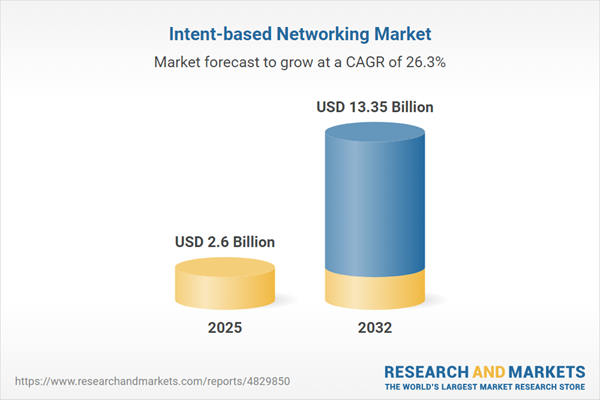Speak directly to the analyst to clarify any post sales queries you may have.
Intent-based networking is transforming enterprise IT management by offering organizations powerful tools to automate, secure, and optimize network operations. As businesses accelerate digital transformation, leaders are finding new ways to unify network innovations with high-level objectives, supporting agility and sustained growth.
Market Snapshot: Growth and Opportunity
The global intent-based networking market currently stands at USD 2.06 billion and is expanding with a compound annual growth rate (CAGR) of 26.26%. Companies worldwide are turning to intent-based solutions to manage increased operational complexity, especially as hybrid and distributed IT environments become more prevalent. Momentum is building due to digital strategies, such as the adoption of multi-cloud platforms, which drive demand for adaptive network management. Regulatory compliance and evolving digital agendas further fuel the integration of these network models, positioning intent-based networking as a critical element in delivering reliable, flexible IT infrastructure across industries.
Scope & Segmentation: Strategic Focus for Intent-based Networking
- Component: Managed services and professional services provide continuous network oversight, enabling automation and embedded security capabilities. These components help enterprises reduce risk, improve operational continuity, and support network automation initiatives.
- Deployment Mode: Cloud deployment supports rapid scaling and resource flexibility, while on-premises options cater to businesses prioritizing data privacy and compliance needs, particularly where heightened regulatory controls are in effect.
- Organization Size: Large enterprises benefit from centralized IT management frameworks, achieving better resource allocation and oversight. Smaller organizations often turn to managed services to maximize their operational effectiveness and achieve needed support.
- End User: Finance, healthcare, manufacturing, telecom, retail, and IT providers adopt intent-based networking to address sector-specific integration, compliance, and security challenges, streamlining operations according to unique sector requirements.
- Application: Automation of workflows, advanced analytics, and smart traffic routing drive productivity improvements and empower organizations to advance digital transformation strategies aligned with business priorities.
- Region: The Americas lead adoption thanks to digital-first strategies, while EMEA focuses on regulatory compliance and governance demands. Asia-Pacific emphasizes edge deployment and diverse digital maturity requirements, reflecting varying business landscapes.
- Technology and Vendor Landscape: Leading technology providers, such as Cisco Systems, VMware, Juniper Networks, and Hewlett Packard Enterprise, continuously develop software-defined networking, telemetry, and interoperability tools within secure architectural frameworks, supporting seamless integration into modern and legacy systems.
Key Takeaways: Strategic Insights for Senior Leadership
- Intent-based networking aligns IT infrastructure with dynamic business objectives, providing organizations the flexibility to adapt to changing markets and technology trends.
- Automation simplifies network management, ensuring consistent enforcement of policies across diverse operational environments, which is vital for governance and compliance.
- Enhanced segmentation and adoption of zero trust architectures bolster network security, empowering organizations to address evolving threats while maintaining regulatory commitments.
- Open-architecture solutions increase scalability and reduce implementation barriers, enabling fast response to business-driven changes in network requirements.
- Regional approaches help organizations address local regulatory obligations and infrastructure maturity, optimizing network investments for efficiency.
- Embracing software-driven frameworks lowers complexity for organizations engaged in multi-regional or decentralized operations, reducing risk and boosting resilience.
Tariff Impact on Procurement and Deployment
Adjustments in U.S. tariff policies and wider global trade shifts are influencing the way enterprises approach network procurement and deployment. A focus on software-centric intent-based networking allows organizations to minimize reliance on physical hardware, addressing potential supply chain vulnerabilities and enhancing adaptability. Collaboration with regional vendors and a focus on compliance-centric product selection are supporting organizations in staying agile, both in regulatory compliance and operational execution.
Methodology & Data Sources
This report synthesizes insight from interviews with network architects, procurement professionals, and cybersecurity experts. Validation through regulatory review and trusted vendor data ensures a robust foundation for senior IT leaders evaluating modernization pathways.
Why This Report Matters
- Delivers practical recommendations for executive teams overseeing network transformation and business continuity amid evolving digital requirements.
- Facilitates long-term technology planning by identifying critical market segments, highlighting key trends, and embedding risk management within each stage of change.
- Prepares technology decision-makers to protect current investments while guiding transitions to scalable, future-ready networking strategies as organizational needs shift.
Conclusion: Strategic Guidance
Intent-based networking provides the automation, security, and operational adaptability essential for ongoing enterprise digital transformation. This analysis equips senior leaders to make confident choices that drive both network resilience and sustainable business growth.
Additional Product Information:
- Purchase of this report includes 1 year online access with quarterly updates.
- This report can be updated on request. Please contact our Customer Experience team using the Ask a Question widget on our website.
Table of Contents
3. Executive Summary
4. Market Overview
7. Cumulative Impact of Artificial Intelligence 2025
Companies Mentioned
The companies profiled in this Intent-based Networking market report include:- Cisco Systems, Inc.
- Juniper Networks, Inc.
- VMware, Inc.
- Hewlett Packard Enterprise Company
- Huawei Technologies Co., Ltd.
- Arista Networks, Inc.
- Ciena Corporation
- Nokia Corporation
- Extreme Networks, Inc.
- Versa Networks, Inc.
Table Information
| Report Attribute | Details |
|---|---|
| No. of Pages | 196 |
| Published | November 2025 |
| Forecast Period | 2025 - 2032 |
| Estimated Market Value ( USD | $ 2.6 Billion |
| Forecasted Market Value ( USD | $ 13.35 Billion |
| Compound Annual Growth Rate | 26.2% |
| Regions Covered | Global |
| No. of Companies Mentioned | 11 |









